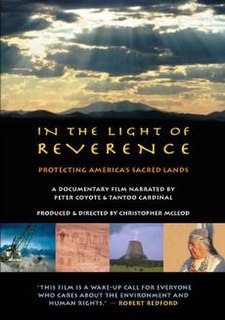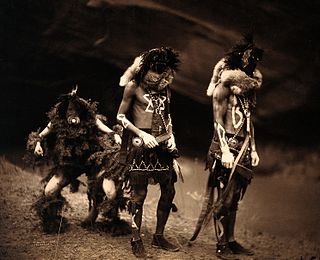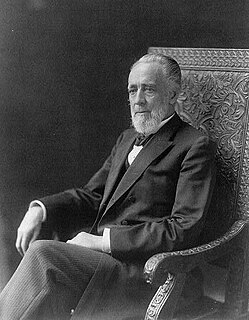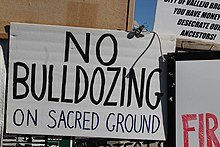
The Native American Graves Protection and Repatriation Act (NAGPRA), Pub. L. 101-601, 25 U.S.C. 3001 et seq., 104 Stat. 3048, is a United States federal law enacted on November 16, 1990.

The American Indian Movement (AIM) is a Native American grassroots movement founded in July 1968 in Minneapolis, Minnesota, initially centered in urban areas to address systemic issues of poverty, discrimination, and police brutality against Native Americans. AIM soon widened its focus from urban issues to include many Indigenous Tribal issues that Native American groups have faced due to settler colonialism of the Americas. These have included treaty rights, high rates of unemployment, Native American education, cultural continuity, and preservation of Indigenous cultures.

Tribal sovereignty in the United States is the concept of the inherent authority of indigenous tribes to govern themselves within the borders of the United States. Originally, the U.S. federal government recognized American Indian tribes as independent nations, and came to policy agreements with them via treaties. As the U.S. accelerated its westward expansion, internal political pressure grew for "Indian removal", but the pace of treaty-making grew nevertheless. The Civil War forged the U.S. into a more centralized and nationalistic country, fueling a "full bore assault on tribal culture and institutions", and pressure for Native Americans to assimilate. In the Indian Appropriations Act of 1871, Congress prohibited any future treaties. This move was steadfastly opposed by Native Americans. Currently, the U.S. recognizes tribal nations as "domestic dependent nations" and uses its own legal system to define the relationship between the federal, state, and tribal governments.

The Religious Freedom Restoration Act of 1993, Pub. L. No. 103-141, 107 Stat. 1488, codified at 42 U.S.C. § 2000bb through 42 U.S.C. § 2000bb-4, is a 1993 United States federal law that "ensures that interests in religious freedom are protected." The bill was introduced by Congressman Chuck Schumer (D-NY) on March 11, 1993. A companion bill was introduced in the Senate by Ted Kennedy (D-MA) the same day. A unanimous U.S. House and a nearly unanimous U.S. Senate—three senators voted against passage—passed the bill, and President Bill Clinton signed it into law.

An Indian reservation is an area of land held and governed by a federally recognized Native American tribal nation whose government is accountable to the U.S. Bureau of Indian Affairs and not to the state government in which it is located. Some of the country's 574 federally recognized tribes govern more than one of the 326 Indian reservations in the United States, while some share reservations, and others have no reservation at all. Historical piecemeal land allocations under the Dawes Act facilitated sales to non–Native Americans, resulting in some reservations becoming severely fragmented, with pieces of tribal and privately held land being treated as separate enclaves. This jumble of private and public real estate creates significant administrative, political and legal difficulties.
A vision quest is a rite of passage in some Native American cultures. It is usually only undertaken by young males entering adulthood. Individual Indigenous cultures have their own names for their rites of passage. "Vision quest" is an English-language umbrella term, and may not always be accurate or used by the cultures in question.

In the Light of Reverence (2001) is a documentary produced by Christopher McLeod and Malinda Maynor (Yumbee). It features three tribal nations, Hopi, the Winnemem Wintu, and the Lakota Sioux, and their struggles to protect three sacred sites. Such sites are central to their understanding of the world and their spiritual responsibilities to care for their homelands.

The Sun Dance is a ceremony practiced by some Native Americans and Indigenous peoples in Canada, primarily those of the Plains cultures. It usually involves the community gathering together to pray for healing. Individuals make personal sacrifices on behalf of the community.

Suzan Shown Harjo is an advocate for Native American rights. She is a poet, writer, lecturer, curator, and policy advocate who has helped Native peoples recover more than one million acres (4,000 km²) of tribal lands. After co-producing the first American Indian news show in the nation for WBAI radio while living in New York City, and producing other shows and theater, in 1974 she moved to Washington, D.C., to work on national policy issues. She served as Congressional liaison for Indian affairs in the President Jimmy Carter administration and later as president of the National Council of American Indians.
Plastic shaman, or plastic medicine people, is a pejorative colloquialism applied to individuals who are attempting to pass themselves off as shamans, holy people, or other traditional spiritual leaders, but who have no genuine connection to the traditions or cultures they claim to represent. In some cases, the "plastic shaman" may have some genuine cultural connection, but is seen to be exploiting that knowledge for ego, power, or money.

The American Indian Religious Freedom Act, Public Law No. 95–341, 92 Stat. 469, codified at 42 U.S.C. § 1996, is a United States federal law, enacted by joint resolution of the Congress in 1978. Prior to the act, many aspects of Native American religions and sacred ceremonies had been prohibited by law.
The Declaration on the Rights of Indigenous Peoples is a legally non-binding resolution passed by the United Nations in 2007. It delineates and defines the individual and collective rights of Indigenous peoples, including their ownership rights to cultural and ceremonial expression, identity, language, employment, health, education, and other issues. Their ownership also extends to the protection of their intellectual and cultural property. The Declaration "emphasizes the rights of Indigenous peoples to maintain and strengthen their own institutions, cultures and traditions, and to pursue their development in keeping with their own needs and aspirations." It "prohibits discrimination against indigenous peoples," and it "promotes their full and effective participation in all matters that concern them and their right to remain distinct and to pursue their own visions of economic and social development".

Native American religions are the spiritual practices of the Native Americans in the United States. Ceremonial ways can vary widely and are based on the differing histories and beliefs of individual nations, tribes and bands. Early European explorers describe individual Native American tribes and even small bands as each having their own religious practices. Theology may be monotheistic, polytheistic, henotheistic, animistic, shamanistic, pantheistic or any combination thereof, among others. Traditional beliefs are usually passed down in the forms of oral histories, stories, allegories, and principles.

Native American civil rights are the civil rights of Native Americans in the United States. Native Americans are citizens of their respective Native nations as well as the United States, and those nations are characterized under United States law as "domestic dependent nations", a special relationship that creates a tension between rights retained via tribal sovereignty and rights that individual Natives have as U.S. citizens. This status creates tension today, but was far more extreme before Native people were uniformly granted U.S. citizenship in 1924. Assorted laws and policies of the United States government, some tracing to the pre-Revolutionary colonial period, denied basic human rights—particularly in the areas of cultural expression and travel—to indigenous people.
Native American self-determination refers to the social movements, legislation, and beliefs by which the Native American tribes in the United States exercise self-governance and decision making on issues that affect their own people.
The Association on American Indian Affairs is a nonprofit human rights charity located in Rockville, Maryland. Founded in 1922, it is dedicated to protecting the rights of Native Americans.
Lyng v. Northwest Indian Cemetery Protective Association, 485 U.S. 439 (1988), was a United States Supreme Court landmark case in which the Court ruled on the applicability of the Free Exercise Clause to the practice of religion on Native American sacred lands, specifically in the Chimney Rock area of the Six Rivers National Forest in California. This area, also known as the High Country, was used by the Yurok, Karuk, and Tolowa tribes as a religious site.

Oak Flat is in Pinal County about 40 miles (64 km) east of Phoenix in the Tonto National Forest, a high desert setting at 3,900 feet (1,200 m) elevation. The land is sacred to Native Americans from the San Carlos Apache Indian Reservation and many other Arizona tribes. This federally-protected area is listed on the National Register of Historic Places, and features a National Forest Service public campground. The landscape includes Apache Leap cliff, the mesa of Oak Flat, and Devil's Canyon, all of which have long been popular with hikers, birders, climbers, off-roaders, hunters, and members of the area's indigenous tribes. Oak Flat has been subject to attempts by the federal government to sell it to mining interests since 2002, against the wishes of the San Carlos Apache tribe.
Several Indigenous peoples who live on the United States–Mexico border have objected to the construction of a border wall on their territories and the militarization of the border by the United States government. The US–Mexico border crosses several Indigenous territories and divides these communities. The barrier erected between the United States and Mexico cuts through and/or affects at least 29 Indigenous tribes, which include Kumeyaay Nation and Tohono O'odham.

The Code of Indian Offenses was an 1883 body of legislation in the United States that, along with other legislation, restricted the religious and cultural ceremonies of Native American tribes.













